FAO Fisheries Circular No. 920 FIRM/C920
Rome, 1997
ISSN 0429-9329
REVIEW OF THE STATE OF WORLD FISHERY RESOURCES: MARINE FISHERIES
by
Marine Resources Service,
Fishery Resources Division,
Fisheries Department,
FAO, Rome, Italy
11. NORTHEAST PACIFIC
FAO Statistical Area 67
INTRODUCTION
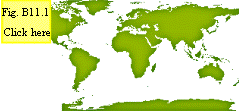
The Northeast Pacific (Figure B11.1) encompasses several distinct regional ocean subareas (i.e. "Large Marine Ecosystems"), including the northern portion of the California Current region, the Gulf of Alaska and the eastern part of the Bering Sea. These subareas embody distinctly different environmental dynamics. The California Current is a classical subtropical eastern ocean upwelling system. The subarctic systems of the Gulf of Alaska and Bering Sea are dominated by the Aleutian Low pressure cell, one of the most intensive, quasi-permanent atmospheric systems on earth. In the Gulf of Alaska, the result is intense coastal convergence which drives anti-clockwise coastal flow around the periphery of the Gulf which interact with coastal runoff to produce embedded frontal zones of concentration of biological processes. The eastern Bering Sea is a shallow shelf system, characterized by tidal mixing and related shelf-sea formations.
PROFILE OF CATCHES
| Figure B11.2 | Figure B11.3 |

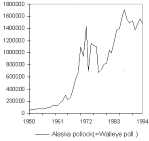 Total reported capture fishery landings for 1994 in this Area totalled 3.0 million
tonnes, a decline of ~184 000 t or nearly 6% from the historical peak landings
of 1993 (Figure B11.2 and Table
XI).
Total reported capture fishery landings for 1994 in this Area totalled 3.0 million
tonnes, a decline of ~184 000 t or nearly 6% from the historical peak landings
of 1993 (Figure B11.2 and Table
XI).
Roughly half of this decline was due to reduced landings of the most abundant
fished species in the region, Alaskan pollock. Since the late 1960s catches
of Alaskan pollock have made up the majority of ISSCAAP Group 32 catches and
dominated the capture totals (Figure B11.3).
| Figure B11.4 | Figure B11.5 |
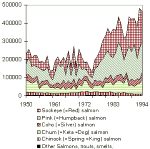
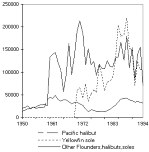 Another major contributor to this year's overall decline in catches was sockeye
salmon, which declined by 51 895 t. During the latter half of the 1970s the
catches of sockeye salmon had increased sharply and, along with similar increases
in catches of pink salmon, resulted in total salmon catches during the 1980s
and 1990s being twice as large as during the 1950s and 1960s (figure
B11.4). This pattern in catches is due largely to improved growth conditions
and increases in the size of certain salmon stocks. Catches of pink salmon in
1994 were virtually the same as in 1993, but overall regional landings of coho
salmon increased in 1994 by 17 438 t, or roughly 77%.
Another major contributor to this year's overall decline in catches was sockeye
salmon, which declined by 51 895 t. During the latter half of the 1970s the
catches of sockeye salmon had increased sharply and, along with similar increases
in catches of pink salmon, resulted in total salmon catches during the 1980s
and 1990s being twice as large as during the 1950s and 1960s (figure
B11.4). This pattern in catches is due largely to improved growth conditions
and increases in the size of certain salmon stocks. Catches of pink salmon in
1994 were virtually the same as in 1993, but overall regional landings of coho
salmon increased in 1994 by 17 438 t, or roughly 77%.
Large reductions in catches also occurred for flatfish (ISSCAAP Group 31)
other than yellowfin sole, which declined by 85 855 t (figure
B11.5) due to regulations designed to keep the overall groundfish catches
within an estimated "optimum yield" limit and to minimize bycatch
of North Pacific halibut and North Pacific snow and king crabs.
Figure B11.6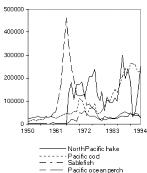 |
Figure B11.7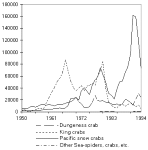 |
Figure B11.8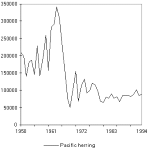 |
| Other stocks for which landings declined significantly were Pacific Ocean perch, Pacific snow crabs, king crabs and Pacific shrimps (Figures B11.6 and B11.7). These declines were partially offset by an increase of 112 045 t in landings of North Pacific hake, a rise of nearly 80 percent (Figure B11.6). Pacific ocean perch were intensely exploited in the 1960s. Being a long-lived, slow-growing species, they are only now showing signs of rebounding from the over-exploitation of three decades ago. After increasing but variable catches throughout the 1950s and early 1960s, the catches of herring plunged by nearly 90% in 1964-65 and have remained at a lower level since (Figure B11.8). |
RESOURCE STATUS AND MANAGEMENT
Salmon Resources
Salmon resources in Area 67 are currently on an increasing trend overall. However, the opposite is true for the coho and chinook salmon stocks of the US Pacific coast which have been in decline. All species are considered fully utilized, except for chinook and coho salmon stocks of Washington, Oregon and California, which are considered overexploited. Canadian salmon stocks are starting to show declining trends. While Canadian catches are expected to improve in 1997 because of the cyclic nature of some stocks, it appears that there is a general trend towards catches that would be lower than in the 1980s. The trend is most apparent for southern stocks of most species, but particularly sockeye and pink from the Fraser River. The period since the mid-1960s has generally been a period of strong population growth which is reflected in strong growth in landings to an all time peak in 1993.
In spite of being near overall historical highs, salmon stocks face increasing pressure from environmental problems, and many of the stocks are already severely impacted. Being anadromous spawners, salmon reproduction is strongly affected by riverine and estuarine habitat degradation caused by logging, mining, oil and gas development, industrial development and urban expansion. Resulting conflicts with other economic sectors make mitigation difficult. Also, large numbers of salmon are caught as bycatch in the groundfish fisheries, another source of conflict and concern. There is also concern that use of hatchery production to help compensate for habitat loss may lead to the destruction of wild stocks.
In summary, chinook and coho salmon are considered overexploited in the California Current region but fully exploited at an appropriate rate off Alaska. Pacific cod is considered to be fully utilized in the Gulf of Alaska, but under-utilized in the Bering Sea, where its abundance is increasing; conversely off British Columbia, Pacific cod abundance is very low, resulting in closures.
Groundfish Resources
Many of the most important groundfish stocks of the North Pacific Ocean followed the same pattern of rapid increase, beginning in the mid-1970s, that marked the large salmon stocks of the subarctic Pacific. Accordingly, the largest groundfish population of them all, the complex of Alaska pollock stocks, held the distinction of being the largest fished population in the world, although in recent years the Peruvian anchoveta has regained this honor.
The Alaskan pollock is considered to be fully utilized. There are four main stocks recognized. Of these, the Eastern Bering Sea stock and the Aleutian Island stock are believed to be at moderately high abundance levels. The Aleutian Basin stock was diminished greatly by exploitation in the international "donut hole" and all fishing was stopped in 1993. The Gulf of Alaska stock has been declining in recent years due to poor recruitment.
The other large gadoid populations in the area, Pacific cod and Pacific hake (also called Pacific whiting) have followed a similar pattern, rising from the mid-1970s to mid-1980s but generally declining thereafter. Currently, Pacific cod abundance is high. It is considered to be fully utilized in the Gulf of Alaska but under-utilized in the Bering Sea where since 1994 the large eastern Bering Sea stock is believed to be increasing in abundance. However, off British Columbia, Pacific cod abundance is very low, resulting in total closures. Pacific hake is considered to be fully utilized. While the largest stock of Pacific cod is in the Bering Sea, Pacific hake is concentrated in the area off the US and Canadian west coasts. Contrary to the Pacific cod, Pacific hake abundance is apparently continuing to decline, currently reaching substantially lower levels than had been available to support the record catches of 1994.
Of the important flatfish populations, the very valuable Pacific halibut resource is considered to be fully utilized although stocks exhibit a general declining trend. Canadian quotas for Pacific halibut remain high despite a decline in individual size. The largest flatfish stock in is the Bering Sea yellowfin sole population. This population followed a pattern similar to that of the salmon and gadoids in increasing rapidly during the 1970s and early 1980s, but while the gadoids have declined after the mid-1980s the yellowfin sole abundance has stayed high. Yellowfin sole is considered to be under-utilized. Flatfish other than halibut and yellowfin sole are abundant and are under-utilized in the Bering Sea and Gulf of Alaska due to bycatch restrictions.
Sablefish is fully utilized throughout the region; Canadian stocks are believed to be healthy but declining. Groundfish stocks off the US Pacific Coast are considered to be fully utilized.
Crab and shrimp resources are at low levels throughout Alaska. However, in Canadian waters, landings and landed value of shellfish continue to increase as new species are added to the list of commercial fisheries.
Small Pelagics
Pacific herring support an extremely valuable fishery, much of it for high-valued roe. In general, since the mid-1970s herring seem to fluctuating in a low to moderate abundance state. The abundance trends vary among the numerous stocks in the region. But overall, the very recent trend is for fairly healthy levels of abundance. In the Bering Sea, where the stocks are believed to be at moderate levels, a portion of the stock, now limited by regulation to 1 000 t, is taken as bycatch by the groundfish fishery. Also the stocks in the Gulf of Alaska are believed to be at moderate abundance levels. Off Canada, herring abundance in the Strait of Georgia remains close to historic high levels. The abundance in the other areas is either average or close to cut off levels. The stocks off the west coast of Vancouver Island are in low abundance, apparently for natural reasons.